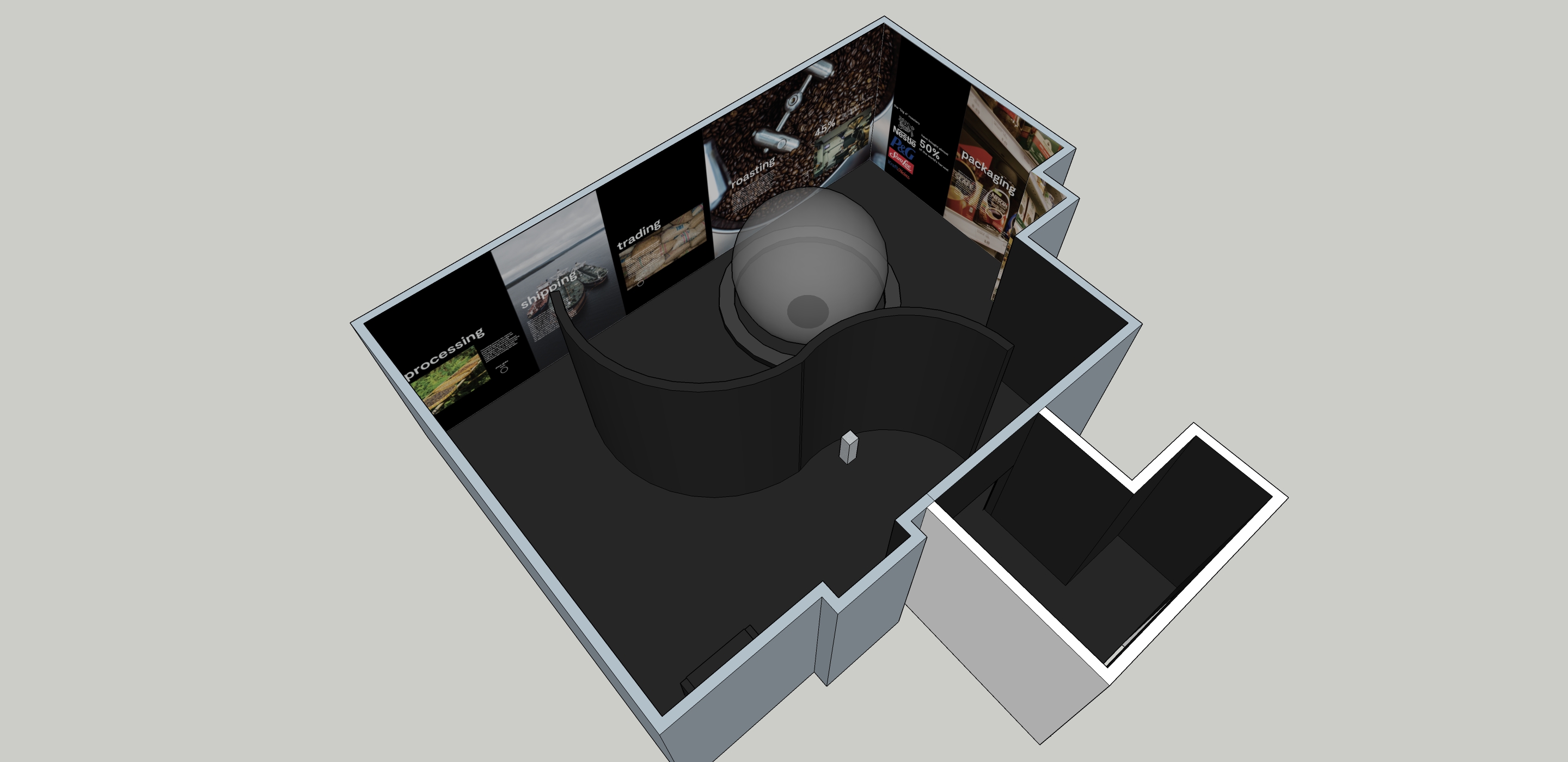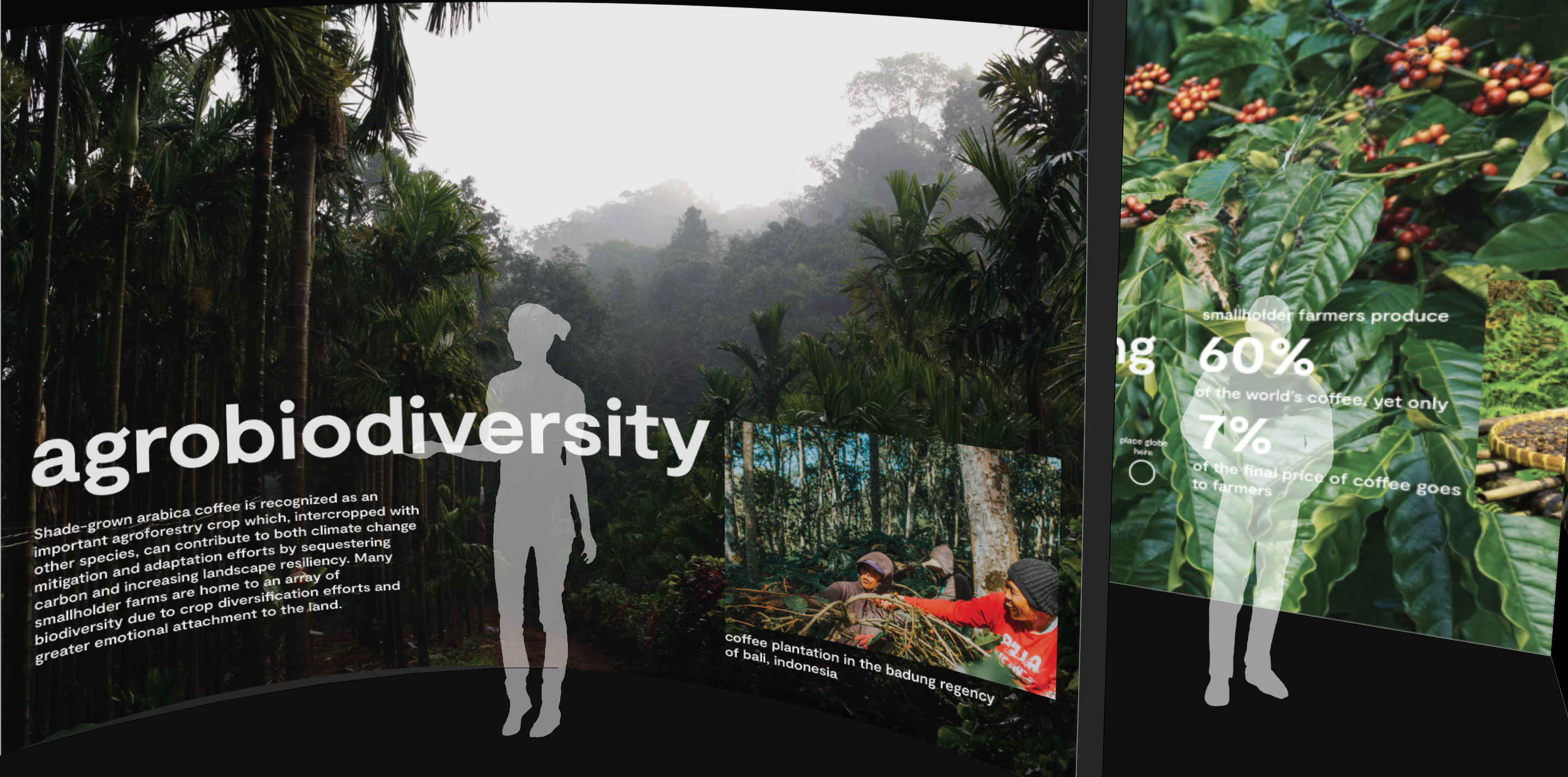What’s In a Cup?
Timeline: 4 weeks
Skills
︎︎︎ Experience Design
︎︎︎ Digital Interaction Design
︎︎︎ Adobe Photoshop
︎︎︎ SketchUp
Skills
︎︎︎ Experience Design
︎︎︎ Digital Interaction Design
︎︎︎ Adobe Photoshop
︎︎︎ SketchUp
Task: Create a temporary (3-4 week) exhibition centered around a social issue. Use digital technology to enhance the visitor’s experience in ways that are not currently being done.
Consider how technology can augment content, increase learning and/or make the museum experience more interactive.
I decided to focus my exhibit on demonstrating the effects of globalization through coffee. The major reason consumers lack the knowledge to appreciate their coffee is that the industry obscures its complexity and diversity in an extremely calculated manner by turning it into a homogenized commodity. Westerners especially are blissfully ignorant of the detrimental effects of the commodity chain, and increasingly disconnected from the long journey from farm to cup.
Through this exhibit, I wanted visitors to be exposed to the realities of the supply chain and inspire them to think more critically about how and what they consume.
If you’re interested in my process for this project, click here.
I decided to focus my exhibit on demonstrating the effects of globalization through coffee. The major reason consumers lack the knowledge to appreciate their coffee is that the industry obscures its complexity and diversity in an extremely calculated manner by turning it into a homogenized commodity. Westerners especially are blissfully ignorant of the detrimental effects of the commodity chain, and increasingly disconnected from the long journey from farm to cup.
Through this exhibit, I wanted visitors to be exposed to the realities of the supply chain and inspire them to think more critically about how and what they consume.
If you’re interested in my process for this project, click here.


Upon entering, visitors are invited to take a handheld magnetic globe from the bin. This will be integral for the rest of the exhibit. They are greeted with the question “what's in a cup?” and intended to read a short introduction. After they take a globe from the bin, they can begin their journey through the rest of the exhibit.

How does it work?
Visitors would spend the majority of their visit familiarizing themselves with the different stages of the coffee supply chain and how the mainstream modern system is affecting social systems and the environment.
Information about the different stages of the supply chain line the entirety of the walls in the space, sometimes flushing floor to ceiling to immerse the visitors in the space as much as possible. The exhibit takes visitors from seed to cup, beginning with cultivation, harvesting, and processing of the coffee beans. It then moves into more industrial aspects of the supply chain, including shipping, trading, roasting, and packaging.
Along with specific events in the supply chain, visitors are exposed to how large-scale agriculture is negatively affecting climate change and agrobiodiversity, as well as how smallholder farmers are helping alleviate some of these negative effects.
Information about the different stages of the supply chain line the entirety of the walls in the space, sometimes flushing floor to ceiling to immerse the visitors in the space as much as possible. The exhibit takes visitors from seed to cup, beginning with cultivation, harvesting, and processing of the coffee beans. It then moves into more industrial aspects of the supply chain, including shipping, trading, roasting, and packaging.
Along with specific events in the supply chain, visitors are exposed to how large-scale agriculture is negatively affecting climate change and agrobiodiversity, as well as how smallholder farmers are helping alleviate some of these negative effects.


Digitally Augmented Interaction
As visitors move through the space, motion sensors on the ground trigger the beginning of video and audio, telling the stories of different actors in the supply chain, like smallholder coffee farmers or someone working in a large scale roasting factory. These motion sensors also trigger a projection, inviting visitors to place their globe onto the wall via powerful magnets.
Upon doing so, a specific event from that part of the supply chain will be electronically loaded onto their globe. Video and audio would stop as visitors leave the threshold of the motion sensors. The sensors are also able to tell if there are two people standing within the threshold, so two invitations would be projected.
Upon doing so, a specific event from that part of the supply chain will be electronically loaded onto their globe. Video and audio would stop as visitors leave the threshold of the motion sensors. The sensors are also able to tell if there are two people standing within the threshold, so two invitations would be projected.

Once visitors have finished familiarizing themselves with the logistics of the supply chain, they can place their personal globe on the ring around the main centerpiece globe. Here, they are able to see their assigned journey play out live throughout the world.

Once you place your globe in the magnetic socket, the projection begins. There are many different actors one visitor could potentially be assigned, which are assigned completely randomly. For example, one person could see the journey from the perspective of a sustenance farmer in Guatemala, while another could see it from a millionaire coffee futures trader in New York City.

Multiple people can place their globes in the ring at one time. Different roles are differentiated by color. This allows visitors to focus on their journey, but also have the option to see other perspectives. Arrows guide the visitor to walk around to different locations on the globe, with images to help illustrate their journey.

Once their commodity chain journey is complete, visitors are invited to take their globes out and keep them as a souvenir if they would like.

